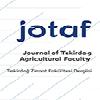Analysis and Assessment of Yield Ranking Models in Triticale (xTriticosecale Wittm.) in Contrasting Environmental Conditions
___
Aljarrah, M., L. Oatway, S. Alberts and C. Bergen, 2014. Variability, heritability and genetic advance in some agronomic and forage quality characters of spring triticale in western Canada. Communications in Agricultural and Applied Biological Sciences, Ghent University, 79(4): 9-18.Banjac B., V. Mladenov, M. Dimitrijevic, S. Petrovic and J. Bocanski, 2014. Genotype × environment interactions and phenotypic stability for wheat grown in stressful conditions- Genetika, Vol 46, No. 3, 799-806
Baychev, V. 2013. Triticale lines and varieties grown under contrasting meteorological conditions. Scientific Works of Instiute of Agriculture - Karnobat, 2(1): 79-86.
Becker, H.C. and J. Leon, 1988. Stability analysis in plant breeding. Plant Breeding, 101, 1-23.
Dhindsa, G.S., A.S. Dosanjh, V.S. Sohn, J.S. Dhindsa and J.C. Goyali, 2002. Genotype x environment interaction for yield components in hexaploid triticale. Proceedings of the 5th International Triticale Symposium, Volume II, June 30 - July 5, 2002, Radzikow, Poland, 199-200.
Farshadfar, E. and M. Farhadi, 2014. AMMI and AMMI based analysis of phenotypic stability in wheat-Agropyron disomic addition lines. Journal of Biodiversity and Environmental Sciences, 5(4), 548-557.
Gabriel, K.R. 1971. The biplot graphic display of matrices with application to principal component analysis. Biometrika, 58: 453-467.
Goyal, A., B.L. Beres, H.S. Randhawa, A. Navabi, D.F. Salmon and F. Eudes, 2011. Yield stability analysis of broadly adaptive triticale germplasm in southern and central Alberta, Canada for industrial end-use suitability. Can. J. Plant Sci., 91: 125-135.
Goyali, J.C. and G.S. Dhindsa, 2003. Stability behaviour of some triticale (xTriticosecale Wittmack) genotypes for yield and yield components. Triticale Topicos, 19: 17-21.
Karimizadeh ,R., M. Mohammadi, N. Sabaghnia, M. K. Shefazadeh and J. Pouralhossini, 2012. Univariate stability analysis methods for determining genotype × environment interaction of durum wheat grain yield. African Journal of Biotechnology, 11(10): 2563-2573.
Martynov, S. 1990. A method for the estimation of crop varieties stability, Biometrical Journal, 7: 887-893.
Lozano-del Río, A.J., V.M. Zamora-Villa, L. IbarraJiménez, S.A. Rodríguez-Herrera, E. de la CruzLázaro and M. de la Rosa-Ibarra, 2009. AMMI analysis of genotype-environment interaction and production potential of forage triticale (X Triticosecale Wittm.). Universidad y Ciencia Tropico Humedo, 25(31): 81-92.
Motzo, R., F. Giunta and M. Deidda, 2001. Factors affecting the genotype x environment interaction in spring triticale grown in a Mediterranea environment. Euphytica, 121, 317-324.
Stoyanov, H. and V. Baychev, 2016a, Achievements and trends in the breeding of triticale in Bulgaria. 9th International Triticale Symposium, Szeged, Hungary, May 23-27, 2016 Book of Abstracts: 20.
Stoyanov, H. and V. Baychev, 2016b. Analysis on "genotype x environment" interaction in Bulgarian triticale (×Triticosecale Wittm.) cultivars. Scientific works of Institute of Agriculture - Karnobat, (in press)
Tsenov, N., D. Atanasova and T. Gubatov, 2013, Genotype x environment effects on the productivity traits of common wheat. I. Nature of interaction. Scientific Works of Institute of Agriculture - Karnobat, 3(1): 57-70.
Tsenov N., D. Atanasova, M. Nankova, A. Ivanova, E. Tsenova, P. Chamurliiski and G. Raykov, 2014. Approaches for grading breeding evaluation of winter wheat varieties for grain yield. Scientific Works of Instiute of Agriculture - Karnobat, 3(1): 21-35
Yan, W. and J. Holland, 2010. A heritabilityadjusted GGE biplot for test environment evaluation, Euphytica: 171, 355-369.
Yan, W. and M.S. Kang, 2003. GGE Biplot Analysis. A Graphical Tool for Breeders, Geneticists, and Agronomists. CRC PRESS, Boca Raton, London, New York, Washington, D.C.
Zobel, R.W., M.J. Wright and H.G. Gauch, 1988. Statistical analysis of a yield trial. Agronomy Journal, 80: 388-393
- ISSN: 1302-7050
- Yayın Aralığı: 3
- Başlangıç: 2004
- Yayıncı: Namık Kemal Üniv. Tekirdağ Ziraat Fak.
Saanen Keçilerinde ?- Laktoglobulin (?-LG) Geni Ekzon 7 Polimorfizmi ve Süt Verimi ile İlişkisi
Turgay TAŞKIN, Çağrı KANDEMİR, Nedim KOŞUM, Güldehan BİLGEN, Raziye IŞIK
The Species of Superfamily Chalcidoidea - Parasites of Aphidophagous Hoverflies
Mile POSTOLOVSKI, Stanislava LAZAREVSKA, Vesna KRSTESKA
Özgür SAĞLAM, Ali Arda IŞIKBER, Hasan TUNAZ, M. Kubilay ER, Fatih BAHADIR, Recep ŞEN
Vine and Berry Responses to Severe Water Stress in Different Stages in cv Syrah (Vitis vinifera L.)
ELMAN BAHAR, Alain CARBONNEAU, İlknur Korkutal
İrfan ÖZTÜRK, Kayıhan Z. Korkut
Hristo STOYANOV, Valentin BAYCHEV, Gallina MIHOVA
Murat DEVECİ, Evren CABİ, Levent ARIN, Ozcan YAVAS
Elif Ceren PEHLİVAN, Birhan KUNTER, Shedia ROYANDAZAGH DANESHVAR
